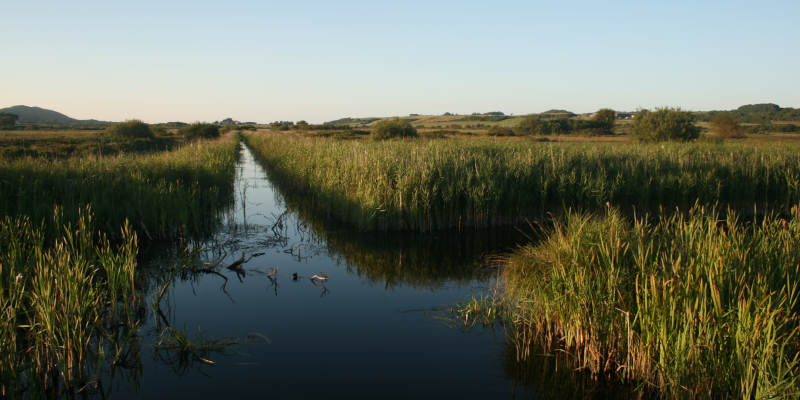Managing peatlands to cut greenhouse gas emissions

Substantial cuts in greenhouse gas emissions could be achieved by raising water levels in agricultural peatlands, according to a new study.
Peatlands occupy just three per cent of the world’s land surface area but store a similar amount of carbon to all terrestrial vegetation, as well as supporting unique biodiversity.
In their natural state, they can mitigate climate change by continuously removing carbon dioxide (CO2) from the atmosphere and storing it securely under waterlogged conditions for thousands of years. But many peatland areas have been substantially modified by human activity, including drainage for agriculture and forest plantations
This results in the release of the equivalent of around 1.5 billion tonnes of CO2 into the atmosphere each year – which equates to three per cent of all global greenhouse gas (GHG) emissions caused by human activities.
This study emphasises the importance of peatlands as a global carbon store and the need to raise water tables in damaged peatlands.
A research team, including scientists from the University of Leeds, studied CO2 emissions in 16 peatland areas and methane emissions in 41 peatland areas across the British Isles, along with data from other countries and estimated the potential reduction in emissions by restoring all global agricultural peatlands.
However, because large populations rely on these areas for their livelihoods, it may not be realistic to expect all agricultural peatlands to be fully rewetted and returned to their natural condition in the near future.
The team therefore also analysed the impact of halving current drainage depths in croplands and grasslands on peat – which cover over 250,000 km2 globally – and showed that this could still bring significant benefits for climate change mitigation. The study estimates this could cut emissions by around 500 million tonnes of CO2 a year, which equates to one per cent of all global GHG emissions caused by human activities.
Published today in Nature, the study included methane data collected by the University of Leeds from two sites on Thorne Moors, which forms part of Yorkshire’s Humberhead Peatlands. Together with Goole, Crowle and Hatfield Moors, these areas represent the largest area (2887 ha) of raised bog in lowland Britain.
The research paper’s co-authors include Professor Andy Baird, Professor Pippa Chapman, Dr Richard Grayson and Professor Joseph Holden, from Leeds’ School of Geography.
Professor Chapman said: “The Humberhead Peatlands are a remnant of a large wetland that used to occupy the landscape.
“Peat has been drained, cut and extracted from the site throughout recorded history for fuel, animal bedding and more recently horticultural use.
“This has left the area with too varied a water table to allow peat formation. Work is ongoing to restore these peatlands and return them to a favourable condition and our latest research shows that this regional effort will be of great benefit from a carbon emissions perspective.”
Professor Baird added: “This study emphasises the importance of peatlands as a global carbon store and the need to raise water tables in damaged peatlands.
“Researchers at Leeds are using newly-developed computer models across several projects to help improve peatland management and simulate the fate of damaged and restored peatlands into the future under a warming climate.”
A large proportion of the global greenhouse gases from peatlands are produced in Europe and Southeast Asia, with the total land area of many countries including the UK now a net source, not a sink, of GHGs due to emissions from degraded peat. The study’s authors say there is a growing recognition of the significance of peatlands for the global climate system, with efforts to curb emissions by conservation of undrained peatlands and rewetting of drained sites intensifying.
Lead author Professor Chris Evans, of the UK Centre for Ecology and Hydrology, said: “Widespread peatland degradation will need to be addressed if the UK and other countries are to achieve their goal of net zero greenhouse gas emissions by 2050, as part of their contribution to the Paris climate agreement targets.
“Concerns over the economic and social consequences of rewetting agricultural peatlands have prevented large-scale restoration, but our study shows the development of locally appropriate mitigation measures could still deliver substantial reductions in emissions.”
Professor Evans and his fellow authors recognise the practical challenges, for example controlling water levels and storage, as well as cultivating crops suited to the waterlogged conditions of peatlands, known as ‘paludiculture’.
Research into wetland-adapted crops is underway but does not yet provide commercially viable large-scale alternatives to conventional farming.
However, the scientists point out there is plenty of scope to partially rewet agricultural peatlands without severely affecting production because many sites are over-drained – sometimes to over two metres – and often when no crop is present.
Professor Holden said: “The Yorkshire and Humber region is host to a huge amount of peatland both in the uplands and lowlands.
“This new research shows that investment in much more peatland restoration in the region, that raises water tables in degraded areas, would really make a big difference to the UK in meeting its net zero carbon emissions targets.”
In addition to increased emissions, drainage of peatlands causes land subsidence and soil compaction, which affects soil health and exposes low-lying areas to increasing flood risk. It also deprives rare wetland-adapted plants, insects and mammals of important habitats.
The study in Nature also involved authors from the Swedish University of Agricultural Sciences, the James Hutton Institute, Bangor University, Durham University, Queen Mary University of London, University of Birmingham, University of Leicester, Rothamsted Research and Frankfurt University.
Further information
Overriding importance of water table in the greenhouse gas balance of managed peatlands is published 21 April in Nature. DOI: 10.1038/s41586-021-03523-1
Main image credit: Chris Evans
For further details, contact the University of Leeds press office via pressoffice@leeds.ac.uk
